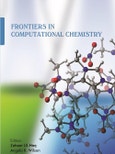Frontiers in Computational Chemistry presents contemporary research on molecular modelling techniques used in drug discovery and the drug development process: computer-aided molecular design, drug discovery and development, lead generation, lead optimization, database management, computer and molecular graphics, and the development of new computational methods or efficient algorithms for the simulation of chemical phenomena including analyses of biological activity.
The fifth volume of this series features these six chapters:
- Recent Advances and Role of Computational Chemistry in Drug Designing and Development on Viral Diseases
- Molecular Modeling Applied to Design of Cysteine Protease Inhibitors – A Powerful Tool for the Identification of Hit Compounds Against Neglected Tropical Diseases
- Application of Systems Biology Methods in Understanding the Molecular Mechanism of Signalling Pathways in the Eukaryotic System
- Implementation of the Molecular Electrostatic Potential over GPUs: Large Systems as Main Target
- Molecular Electron Density Theory: A New Theoretical Outlook on Organic Chemistry
- Frontier Molecular Orbital Approach to the Cycloaddition Reactions
Table of Contents
Chapter 1 Recent Advances and Role of Computational Chemistry in Drug Designing and Development on Viral Diseases
- Introduction
- Structure-Based Computational Methods in Drug Designing
- Finding the Target Structure
- Pharmacophore Modeling
- Ligand Docking
- De Novo Design
- Ligand Based Computational Methods in Drug Designing
- Quantitative Structure Activity Relationships (Qsar)
- Pharmacophore Modeling
- Virtual Screening
- Scaffold Hopping
- Multi Target Drug Designing
- Role of Quantum and Molecular Mechanics in Drug Designing
- Homology Modeling
- Molecular Dynamic Simulations
- Molecular Mechanics Force Fields (Mm2, Mm3 and Mm4)
- Merck Molecular Force Field (Mmff)
- Universal Force Field (Uff)
- Chemistry at Harvard Molecular Mechanics (Charmm)
- Assisted Model Building with Energy Refinement (Amber)
- Quantum/Molecular Mechanics
- Fragment Molecular Orbital Method
- A Brief Overview of the Role of Cadd in the Development of Drugs
- Against Viral Diseases
- Ebola Virus
- Zika Virus
- Hepatitis C Virus
- Coronavirus
- Future Perspective
- Consent for Publication
- Conflict of Interest
- Acknowledgements
- References
Chapter 2 Molecular Modeling Applied to Design of Cysteine Protease Inhibitors - a Powerful Tool for the Identification of Hit Compounds Against Neglected Tropical Diseases
- Introduction
- Virtual Screening in Drug Development
- Cysteine Proteases and Their Catalytic Mechanism
- Molecular Modeling Applied to the Design of Cysteine Protease
- Inhibitors
- Igor José Dos Santos Nascimento, Thiago Mendonça De Aquino, Paulo Fernando Da Silva
- Santos-Júnior, João Xavier De Araújo-Júnior and Edeildo Ferreira Da Silva-Júnior
- Trypanosoma Cruzi (Cruzain)
- Plasmodium Falciparum (Falcipain)
- Chikungunya (Nsp2)
- Schistosoma Mansoni (Smhdac8)
- Other Cysteine Proteases
- Cathepsin Family
- Enterovirus 71 (3Cpro) and Coronavirus (3Clpro)
- Caspase Family
- Critical Steps and Limitations of Virtual Screening Campaigns
- Conclusion and Future Outlook
- Consent for Publication
- Conflict of Interest
- Acknowledgements
- References
Chapter 3 Application of Systems Biology Methods in Understanding The Molecular Mechanism of Signalling Pathways in the Eukaryotic System
- Introduction
- Intercellular Signalling Pathways
- What is Wnt?
- Types of Wnt Signalling Pathway
- Canonical Pathway
- Β-Catenin Dependent Canonical Pathway
- Β-Catenin Independent Canonical Pathway
- Non-Canonical Signalling Pathway
- Wnt/Planar Cell Polarity (Pcp) Pathway
- The Wnt/Ca2+ Pathway
- Significance of the Wnt Signalling Pathway
- Importance of Wnt Pathways in Defence
- Wnt Pathways and Cancers
- Wnt Pathways and Other Diseases
- Application of Computational Methods to Understand Signalling
- Pathways
- General Concept and Principle of Pathway-Based Analysis
- Pathway and Network Analysis for Proteomics
- Resources for Pathway-Based Analysis
- Application of Systems Biology Tools to Decipher Wnt Signalling: Targeting Modulators
- Of Wnt Signalling for Therapy
- Inhibitors Blocking Fzd and Dvl Protein
- Porcupine Enzyme Inhibitors
- Tnks Enzyme Inhibitors
- Gsk-3Β Targeted Inhibitors for the Activation of Wnt Signalling
- Natural Products as Wnt Inhibitors
- Conclusion
- Consent for Publication
- Conflict of Interest
- Acknowledgements
- References
Chapter 4 Implementation of the Molecular Electrostatic Potential Over Gpus: Large Systems as Main Target
- Introduction
- Graphics Processing Units in Quantum Chemistry
- Evaluating the Mep Using Quantum Chemistry Methods
- Implementations to Evaluate the Molecular Electrostatic
- Potential
- Full Evaluation of the Mep
- Linear Scaling Technique
- Screening of the Mep Through Short- and Long-Range
- Interactions
- Evaluation of the Mep Over Gpus
- Conclusion
- Consent for Publication
- Conflict of Interest
- Acknowledgements
- References
Chapter 5 Molecular Electron Density Theory: a New Theoretical Outlook on Organic Chemistry
- Introduction
- Conceptual Density Functional Theory (Cdft) Indices
- Global Cdft Indices
- Electronic Chemical Potential (Μ)
- Chemical Hardness (Η) and Softness (S)
- Electrophilicity Index (Ω)
- Nucleophilcity Index (N)
- Local Cdft Indices
- Fukui Functions
- Parr Functions
- Reactivity Indices for Free Radicals
- Lewis-Like Structure from Topological Analysis of Electron
- Localization Function (Elf)
- Exploring the Potential Energy Surface (Pes)
- Global Electronic Flux in the Lowering of Activation Energies:
- The Gedt Concept
- Revealing the Mechanism and Electron Density Transfer By
- Bonding Evolution Theory
- Revealing the Electron Density Distribution by Baders' Theory Of
- Atoms in Molecules
- Topological Analysis of the Electron Density Distribution and Search for Critical Points
- The Sign of Laplacian of Electron Density
- Nci Gradient Isosurfaces
- Qtaim Topological Analysis Performed Under Medt
- Applications of Molecular Electron Density Theory
- Diels-Alder Reactions
- Electrocyclic Reactions and Sigmatropic Rearrangements
- [3+2] Cycloaddition Reactions
- Conclusion
- Consent for Publication
- Conflict of Interest
- Acknowledgements
- References
Chapter 6 Frontier Molecular Orbital Approach to The Cycloaddition Reactions
- Introduction
- 1,3-Dipole/Ylide
- Classification of 1,3-Dipoles
- Allyl Anion Type 1,3-Dipoles
- Propargyl/Allenyl Anion Type 1,3-Dipoles
- The Dipolarophile
- Mechanism of 1,3-Dipolar Cycloaddition
- Regioselectivity in 1,3-Dipolar Cycloaddition
- Reactivity
- Conclusion
- Consent for Publication
- Conflict of Interest
- Acknowledgements
- References
- Subject Index
Author
- Angela K. Wilson
- Zaheer-Ul-Haq Qasmi










